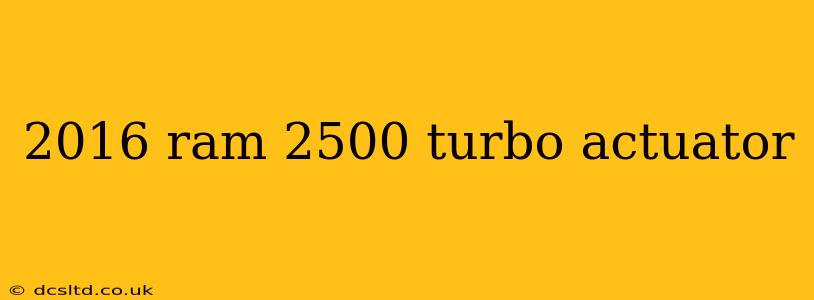The 2016 Ram 2500, a powerhouse of a truck, relies on its turbocharger to deliver impressive power. A crucial component of this system is the turbo actuator, a small but vital part responsible for controlling the turbocharger's boost pressure. When this actuator malfunctions, it can lead to significant performance issues, reduced fuel efficiency, and even engine damage. This comprehensive guide will walk you through understanding the turbo actuator, troubleshooting potential problems, and navigating the replacement process.
What is a Turbo Actuator?
The turbo actuator is essentially a small motor that adjusts the vanes within the turbocharger. These vanes control the amount of exhaust gas flowing through the turbine, directly impacting the boost pressure. Think of it as the throttle for your turbo – it regulates how much "air" the turbo is pushing into the engine. A properly functioning actuator ensures optimal boost pressure for peak engine performance across various RPM ranges. In simpler terms, it ensures the turbocharger works efficiently and doesn't overboost or underboost.
Common Problems with the 2016 Ram 2500 Turbo Actuator
Several issues can arise with the turbo actuator, leading to noticeable problems in your truck's performance. These include:
- Reduced Engine Power: This is often the most prominent symptom. If the actuator malfunctions, it may not be able to regulate boost properly, leading to a significant drop in power.
- Rough Idle: An erratic idle might indicate that the turbo actuator isn't providing consistent boost, resulting in inconsistent engine performance.
- Check Engine Light: This is your car's way of telling you something is wrong! A check engine light, often accompanied by a diagnostic trouble code (DTC), points to a possible actuator failure.
- Excessive Smoke: If the turbo is overboosting or underboosting due to a faulty actuator, it can lead to excessive white or black smoke from the exhaust.
- Boost Gauge Readings: If you have a boost gauge installed, you can directly monitor the boost pressure. Inconsistent or erratic readings strongly suggest an issue with the turbo actuator.
How to Troubleshoot a Faulty Turbo Actuator
Before jumping to conclusions and ordering a replacement, it's crucial to troubleshoot the problem systematically. This often involves:
1. Diagnostic Trouble Codes (DTCs):
Use an OBD-II scanner to retrieve any stored DTCs. These codes provide valuable clues regarding the specific problem. Often, a specific code directly related to the turbocharger or boost pressure control system will point to the actuator.
2. Visual Inspection:
Carefully inspect the turbo actuator for any visible damage, such as loose wiring, broken connectors, or physical damage to the actuator itself. Look for signs of leaks or wear and tear.
3. Actuator Testing:
This step often requires specialized tools and knowledge. Some tests involve applying vacuum to the actuator and checking its movement. Improper movement indicates a likely malfunction. It's highly recommended to consult a qualified mechanic for this step.
Replacing the Turbo Actuator
Replacing a turbo actuator is generally a more involved procedure than simple troubleshooting. It often requires specialized tools and a thorough understanding of the vehicle's systems. Due to the complexity and potential for damage, this is best left to a professional mechanic experienced with the 2016 Ram 2500's turbo system.
Is it Expensive to Replace a Turbo Actuator?
The cost to replace a 2016 Ram 2500 turbo actuator varies depending on several factors:
- Part Cost: The price of the actuator itself can fluctuate based on the brand and where you purchase it.
- Labor Costs: This will likely be a significant portion of the overall cost, as it requires specialized knowledge and tools.
- Additional Repairs: Sometimes, associated problems are discovered during the repair process, adding to the expenses.
Can I replace it myself?
While technically possible for those with extensive mechanical experience and the right tools, replacing the turbo actuator is a complex job that's best left to professionals to avoid further damage.
This information should be seen as guidance only. For specific repair needs, always consult a qualified mechanic specializing in diesel trucks.
